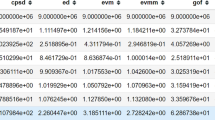Abstract
The demand for spectrum is rising by the day as the number of consumers using the spectrum increases. However, the spectrum’s coverage is constrained to a certain area dependent on the local population. Then, researchers come up with an idea of allocating secondary users in the spectrum in the absence of primary users. For this process, a new scheme has been raised known as spectrum sensing in which the primary user’s presence using a variety of procedures. The device used for this process is called Cognitive radio. The spectrum sensing process involves gathering the signal features from the spectrum and then a threshold will be set depending on those values. With this threshold, the final block in Cognitive radio will decide whether the primary user is present or not. The techniques that are involved in spectrum sensing are energy detection, matched filtering, correlation, etc. These techniques cause a reduction in the probability of detection and involve a complex process to sense the spectrum. To overcome these drawbacks, the optimal signal is constructed from the original signal, and this, the spectrum is sensed. This process provides better results in terms of the probability of detection. To increase the scope of the research, the entropy features are extracted and trained with an LSTM based deep learning architecture. This trained network is tested with hybrid a feature which is a combination of both power-optimized features and entropy features. This process derives the spectrum status along with the accuracy and loss curves. The proposed method reduces complexity in sensing the spectrum along with that it produces an accuracy of 99.9% and the probability of detection of 1 at low PSNR values, outcomes when compared to cutting-edge techniques.
Access this chapter
Tax calculation will be finalised at checkout
Purchases are for personal use only
Similar content being viewed by others
References
Centre for Remote Imaging, Sensing and Processing (CRISP). https://crisp.nus.edu.sg/~research/tutorial/em.htm. Accessed 13 Feb 2023
Electronic notes, ‘Rayleigh Fading’. https://www.electronics-notes.com. Accessed 13 Feb 2023
Wu, J., Luo, T., Yue, G.: An energy detection algorithm based on double-threshold in cognitive radio systems. In: International Conference on Information Science and Enginneering, pp. 493–496. Zhanjiajie (2009)
Maleki, S., Pandharipande, A., Leus, G.: Two-degree spectrum sensing for cognitive radios. In: IEEE International Conference on Acoustics, Spe. and Sig. Proc., IEEE, pp. 2946–2949, Texas, USA (2010)
Plata, D.M.M., Reatiga, A.G.A.: Evaluation of strength detection for spectrum sensing based at the dynamic desire of detection threshold. J. Procedia Eng. 35, 135–143 (2012)
Zhang, X., Chai, R., Gao, F.: Matched cleanout based spectrum sensing and energy degree detection for the cognitive radio network. In: IEEE Global Conference on Signal and Information Processing, IEEE, pp. 1267–1270, Atlanta (2014)
Sutanu, G.: Performance analysis based on a comparative study between multipath Rayleigh fading and AWGN channel in the presence of various interference. Int. J. of Mob. Netw. Commun. Telematics, 4, 15–22 (2014)
Subramaniam, S., Reyes, H., Kaabouch, N.: Spectrum occupancy measurement: an autocorrelation based scanning approach using USRP. In: IEEE Wireless and Microwave Technology Conference on IEEE, pp. 1–5, Barcelona (2015)
Al-Badrawi, M.H., Kirsch, N.J.: An EMD-based double threshold detector for spectrum sensing in cognitive radio networks. In: Vehicular Technology Conference. IEEE, pp. 1–5. Glasgow, UK (2015)
Sai Suneel, A., Prasanthi, K.: Multiple input multiple output cooperative communication technique using for spectrum sensing in cognitive radio network. In: IEEE Int. Conference on Signal Processing Communication Power and Embedded System, IEEE, pp. 2052–2063, Chennai (2016)
Arjoune Y., Mrabet Z. E., Ghazi H. E. and Tamtaoui A. : Spectrum sensing: Enhanced energy detection technique based on noise measurement. In: IEEE 8th Annual Computing and Communication Workshop and Conference, IEEE, pp. 828–834, Las Vegas (2018)
Arjoune, Y., Kaabouch, N.: On spectrum sensing, a machine learning method for cognitive radio systems. In: IEEE International Conference on Electro Information Technology IEEE, pp. 333–338. Ecuador (2019)
Sai Suneel, A., Shiyamala, D.S.: A novel energy detection of spectrum based on noise measurement a review. J. Adv. Res. Dyn. Control Syst. 11, 870–873 (2019)
Sai Suneel, A., Shiyamala, D.S.: Dynamic threshold selection through noise variance for spectrum sensing. Int. J. Eng. Adv. Tech. 8, 23–234 (2019)
Sai Suneel, A., Shiyamala, S.: Peak detection based energy detection of a spectrum under Rayleigh fading noise environment. J. Ambient Intell. Humanized Comput. 12, 4237–4245 (2021)
Author information
Authors and Affiliations
Corresponding author
Editor information
Editors and Affiliations
Rights and permissions
Copyright information
© 2023 The Author(s), under exclusive license to Springer Nature Switzerland AG
About this paper
Cite this paper
Suneel, A.S., Shiyamala, S. (2023). An Innovative AI Architecture for Detecting the Primary User in the Spectrum. In: Chaubey, N., Thampi, S.M., Jhanjhi, N.Z., Parikh, S., Amin, K. (eds) Computing Science, Communication and Security. COMS2 2023. Communications in Computer and Information Science, vol 1861. Springer, Cham. https://doi.org/10.1007/978-3-031-40564-8_16
Download citation
DOI: https://doi.org/10.1007/978-3-031-40564-8_16
Published:
Publisher Name: Springer, Cham
Print ISBN: 978-3-031-40563-1
Online ISBN: 978-3-031-40564-8
eBook Packages: Computer ScienceComputer Science (R0)




